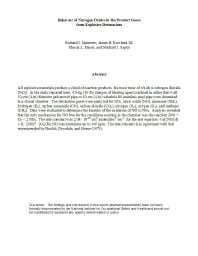Mining Publication: Behavior of Nitrogen Oxides in the Product Gases from Explosive Detonations
Original creation date: January 2006
Authors: RJ Mainiero, JH Rowland, ML Harris, MJ Sapko
NIOSHTIC2 Number: 20029762
Proceedings of the 32nd Annual Conference on Explosives and Blasting Technique, Dallas, Texas, January 29-February 1, 2006. Cleveland, OH: International Society of Explosives Engineers, 2006; 2:1-10
In recent years, the toxic fumes generated by explosives have been a concern for blasters, explosive manufacturers, and mining companies. In the Western United States, blasters have been seeking ways to control the generation of nitrogen dioxide, a very toxic gas that can be produced by large blasts at surface coal mines. In the study reported here, 10 lb. charges of blasting agent confined in either thin-wall 4-inch diameter galvanized pipe or 4-inch schedule-80 stainless steel pipe were detonated in a closed chamber. The detonation gases were analyzed for nitrogen dioxide, nitric oxide (NO), ammonia, hydrogen, carbon monoxide, carbon dioxide, nitrogen, oxygen, and methane. Data were evaluated to determine the kinetics of the oxidation of NO to nitrogen dioxide. The information on NO oxidation kinetics provided in this paper will prove useful in efforts to model the behavior of NO and nitrogen dioxide in clouds of detonation products near blasting operations.

NIOSHTIC2 Number: 20029762
Proceedings of the 32nd Annual Conference on Explosives and Blasting Technique, Dallas, Texas, January 29-February 1, 2006. Cleveland, OH: International Society of Explosives Engineers, 2006; 2:1-10
- A 20-Liter Furnace Test Method to Determine the Combustion Gas Toxicity of Conveyor Belts
- Blasting and Explosives
- Chemical and Physical Factors that Influence N0x Production During Blasting: Exploratory Study
- Dangers of Toxic Fumes from Blasting
- Effects of Sintered Metal Diesel Particulate Filter System on Diesel Aerosols and Nitric Oxides in Mine Air
- Factors Affecting ANFO Fumes Production
- Factors Affecting Fumes Production of an Emulsion and ANFO/Emulsion Blends
- Monitoring and Removal of CO in Blasting Operations
- Performance of RETIMET Metal Foam Vents on Explosion-Proof Enclosures
- A Technique for Measuring Toxic Gases Produced by Blasting Agents
- Work Principle for Predicting Explosive Toxic Fumes